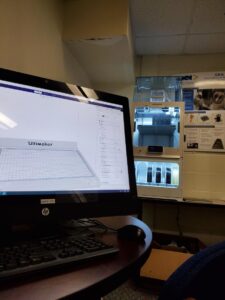Welcome to the Post Processing page!
Much like other manufacturing methods, there exists a slew of post processing techniques available for 3D printing, although some techniques may be more suitable than others depending on the material and its properties. Shown below are a number of post processing techniques that can be used
Joining Parts
-
ABS Welding
- As stated in the material guidelines, ABS is very soluble in the presence of esters and ketones, most prominent of which being acetone which is often used as paint thinner. By applying a small amount of acetone to a joint between two plastic parts, the solvent acts similarly to plastic cement, melting the material before allowing the two pieces to join as one with a joint as strong as the original material. Keep in mind that this process will only work for ABS as PLA will begin to degrade in the presence of acetone due to its chemical composition.
-
Gluing
- For most other materials such as PLA, PETG, or Nylon, the usual plan of attack for joining two parts will be the application of adhesives such as glue or epoxy depending on your intended applications. Keep in mind when using certain epoxies or hot glue on temperature sensitive materials, such as PLA, you may encounter warping as the plastic will soften in the presence of higher temperatures.
Refining Surface Finish
-
Dry Sanding/Wet Sanding
- Sanding is a tried and true method of increasing surface finish that unfortunately will demand the most time out of any other process. As the name suggests, using a progressive line of rough to fine grit sandpaper will remove blemishes, unneeded features, and layer lines until a smooth surface finish is achieved. Be mindful of course of the amount of material that is removed through these abrasive techniques and ensure that you do not unintentionally sand too much.
-
Application of Heat
- The application of heat can be a quick and easy option for smoothing the surface finish of temperature sensitive materials such as PLA. Temperatures in the neighborhood of 60-70 degrees centigrade will cause the plastic to become more pliable and allow some rougher features to reach a smoother finish.
-
Epoxy Resin
- Epoxy resin is a popular option for producing a glossy finish on materials such as PLA that cannot be smoothed by acetone exposure like ABS. When applied to the surface through brushing, epoxy resin will fill in small gaps and defects, such as the ones between layer lines before hardening into a smooth finish that can be sanded further if desired.
-
Acetone Vapor Exposure
- One of the most popular surface finishing processes for ABS is the exposure of the model to acetone vapors which will cause the outer surface of the print to begin melting together into a singular surface. This can be performed by leaving an open container of acetone underneath the suspended model inside of a sealed space as the vapors produced by acetone are not only toxic but also flammable. Recommended exposure time ranges from 10 to 20 minutes, although different times may be required depending on the size of a particular print. It’s very important to ensure that your print is not over exposed as it will begin to deform the more the solvent vapors are allowed to break down the material.
-
THF Vapor Exposure
- Much like ABS, THF (tetrahydrofuran) is a highly caustic solvent that is more suitable for usage on PLA and avoids the deformation caused by the usage of acetone on the material. The process is much the same however, exposing the print to vapors of the solvent for a set period of time will cause the surface features to form into one smooth finish albeit an exposure of too long will cause deformation that can destroy the print. Again, much like acetone, THF and the vapors it produces are highly toxic, so heavy ventilation is recommended if this method is employed.
Advanced Training Hub







